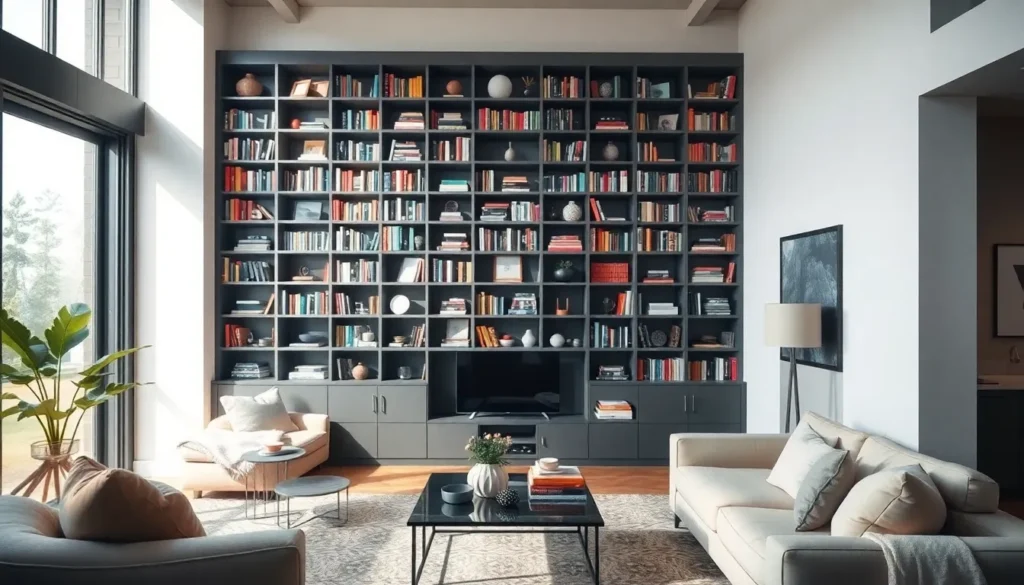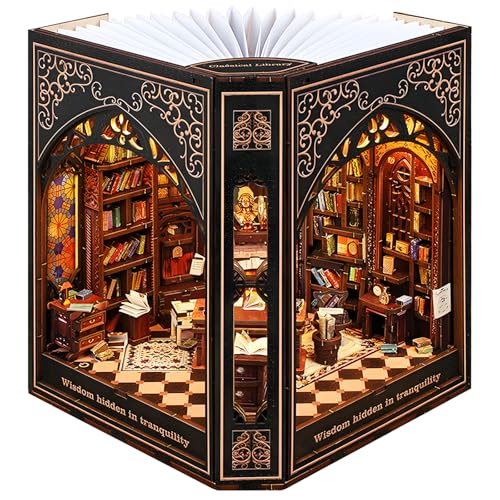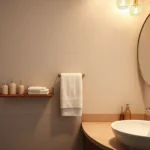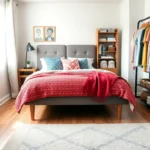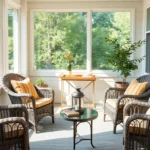We’ve all stared at that empty wall wondering how to transform it into something both functional and beautiful. Bookshelves aren’t just storage answers anymore – they’re statement pieces that can completely revolutionize your living space while showcasing your personality and style.
Whether you’re working with a cozy apartment corner or an expansive home library we’re about to share game-changing bookshelf ideas that’ll make your friends wonder where you hired your interior designer. From floating shelves that create the illusion of more space to built-in units that maximize every inch these creative answers work for any budget and skill level.
Ready to turn your book collection into a stunning focal point? We’ve gathered the most innovative and practical bookshelf designs that combine smart storage with eye-catching aesthetics to help you create the perfect reading nook or display area you’ve always dreamed of.
Floating Wall Shelves for Modern Minimalism
Floating shelves create the illusion of weightless storage while maintaining clean lines that define contemporary design. We’ve found these shelving answers perfect for showcasing books without overwhelming your space’s visual balance.
Invisible Bracket Systems
Hidden mounting hardware transforms ordinary wall shelves into sleek floating displays. We recommend blind shelf supports that slip inside hollow shelves, creating seamless lines without visible brackets. These systems typically support 30-50 pounds per shelf depending on wall type and mounting depth.
Professional installers often use French cleat systems for heavier book collections. This method involves mounting a beveled strip to the wall and a matching piece to the shelf back. The interlocking design distributes weight evenly while maintaining the floating appearance.
Toggle bolts work best for drywall installations when studs aren’t available. We suggest using heavy duty toggles rated for at least 75 pounds to ensure your book collection stays secure. Always mark level lines before drilling to achieve perfectly aligned shelves.
Geometric Arrangements
Asymmetrical patterns create visual interest while breaking traditional horizontal shelf layouts. We love arranging floating shelves in zigzag formations or stepped configurations that draw the eye upward. This approach works especially well in narrow hallways or beside staircases.
Clustered rectangular shelves form modern gallery walls when mixed with different sizes. Try combining 24-inch, 18-inch, and 12-inch shelves in groups of three or five for balanced compositions. Leave 8-12 inches between each shelf to prevent crowding.
Triangle and hexagon shaped floating shelves add unexpected geometry to reading corners. These unique forms work best as accent pieces rather than primary storage, perfect for displaying a few special books or decorative objects alongside your collection.
Color-Coordinated Display Options
Monochromatic shelf finishes blend seamlessly with wall colors for subtle integration. We often paint floating shelves to match the wall color, creating depth through shadows rather than contrasting materials. This technique makes small rooms feel larger while keeping focus on the books themselves.
Natural wood tones warm up stark white walls without adding visual weight. Light oak, maple, or birch floating shelves complement minimalist interiors while providing organic texture. These finishes pair beautifully with both colorful book spines and neutral collections.
Matte black shelves create striking contrast against light walls for dramatic effect. This bold choice works particularly well in modern spaces with industrial elements like exposed brick or concrete. The dark shelves make bright book covers pop while maintaining sophisticated appeal.
Built-In Floor-to-Ceiling Bookshelves
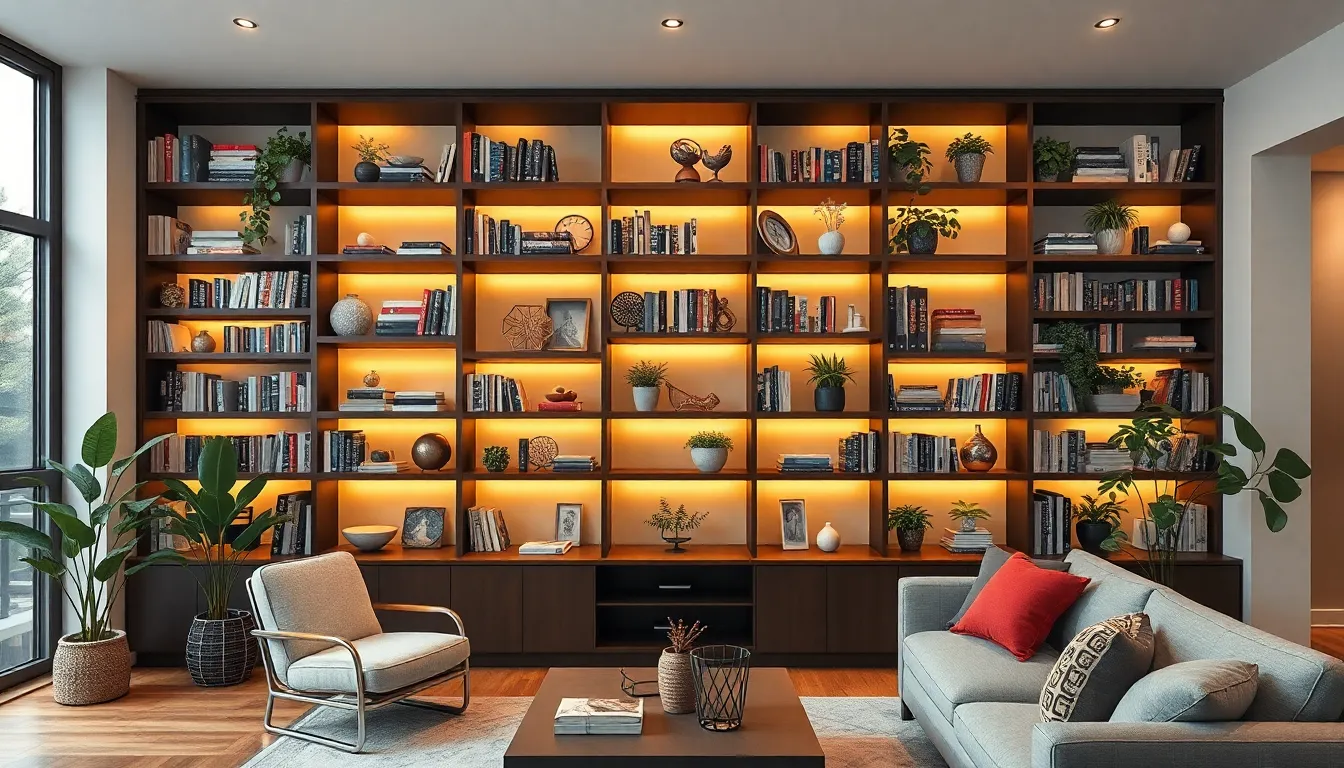
Built-in floor-to-ceiling bookshelves transform ordinary walls into stunning literary landscapes that maximize every inch of vertical space. These permanent installations create dramatic focal points while providing exceptional storage capacity for extensive book collections.
Custom Carpentry Answers
Customized fit becomes the cornerstone of successful built-in bookshelf projects. Custom carpentry allows us to design bookshelves that perfectly match our room’s unique dimensions and architectural features, ensuring seamless integration with existing elements like windows, doors, and trim work.
Material selection opens endless possibilities for creating distinctive looks. We can choose from various materials including hardwood for traditional elegance, MDF for smooth painted finishes, or veneer options that complement our room’s existing decor and color scheme.
Design flexibility enables us to incorporate our personal style preferences. Whether we prefer modern clean lines, classic molding details, or eclectic mixed elements, custom carpentry answers adapt to any architectural style from contemporary minimalism to traditional sophistication.
Space-Maximizing Designs
Room integration transforms underutilized wall space into functional storage areas. We can incorporate these floor-to-ceiling systems into home offices for professional document storage, dining rooms for displaying fine china collections, or living rooms for showcasing our favorite literary works.
Corner answers maximize storage potential in rooms with irregular layouts. Incorporating corner units helps us use awkward spaces that typically remain empty, creating continuous storage flow around room perimeters and increasing overall capacity significantly.
Vertical coverage provides ample storage for books and decorative items. These installations can accommodate thousands of books while leaving space for artwork, plants, family photos, and collectibles that personalize our living spaces.
Integrated Lighting Features
Ambient lighting creates warm atmospheres within our bookshelf displays. Adding LED strips or small spotlights throughout the shelving system illuminates our book spines and decorative objects, creating inviting glows that enhance evening reading sessions.
Functional lighting serves practical purposes for daily use. We can install task lighting in exact areas like reading nooks or study zones, ensuring adequate illumination for comfortable browsing and reference work without straining our eyes.
Highlighting capabilities showcase our most treasured items effectively. Strategic placement of accent lights draws attention to special collections, rare books, or meaningful decorative pieces, transforming our bookshelves into curated gallery displays.
Ladder-Style Leaning Bookshelves
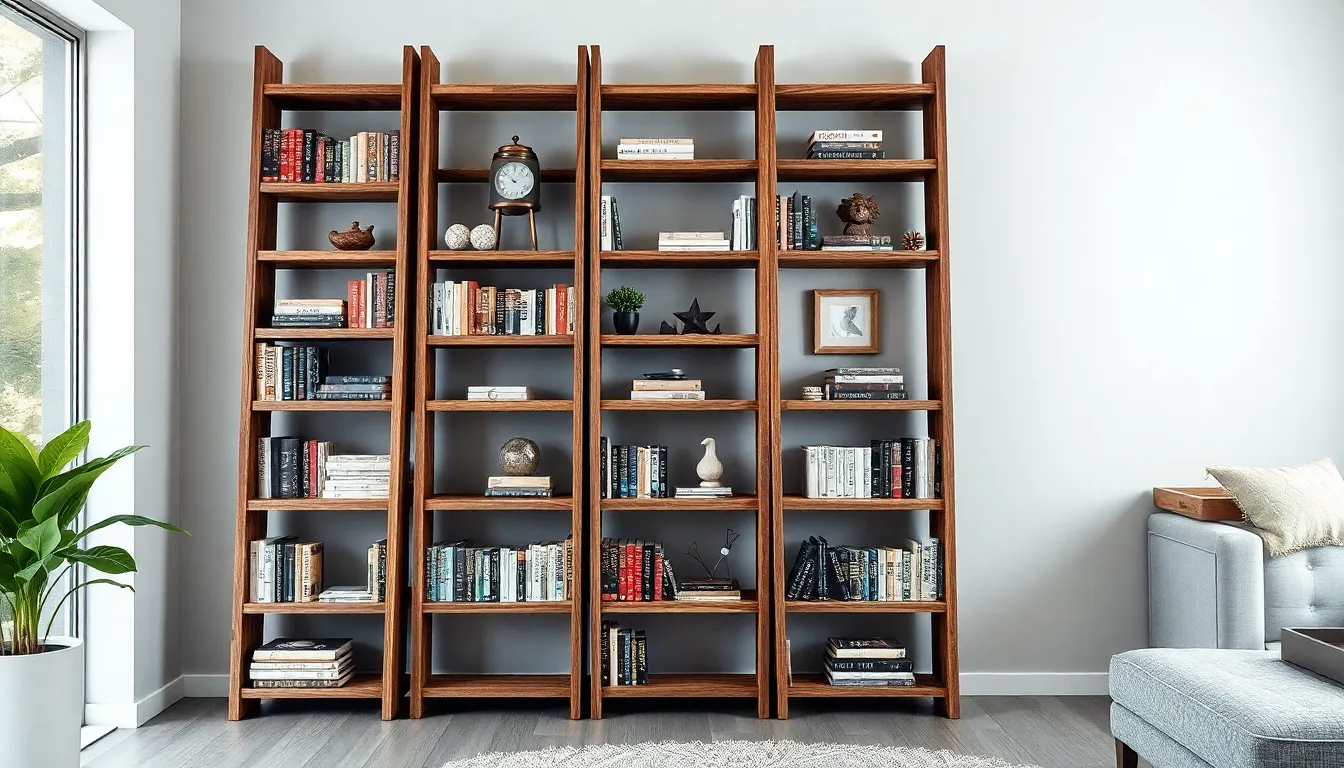
Ladder style leaning bookshelves offer a perfect blend of functionality and modern aesthetics for any room. These freestanding frames lean gracefully against walls while maximizing vertical space without requiring permanent installation.
Rustic Wood Finishes
Rustic wood finishes transform ladder bookshelves into warm focal points that complement traditional and farmhouse decor styles. Distressed wood surfaces create authentic vintage appeal while maintaining the durability needed for heavy book collections. Weathered finishes add character to any space and bring natural textures that soften modern interiors. These materials withstand daily use while developing beautiful patina over time.
Industrial Metal Frames
Industrial metal frames deliver sleek contemporary style with their open geometric designs and minimalist construction. Metal construction provides exceptional stability for displaying books, plants, and decorative items across multiple tiers. These frames suit various interior themes from modern lofts to urban apartments while offering versatile display options. Open framework designs create visual lightness that prevents rooms from feeling cluttered or overwhelmed.
Adjustable Shelf Heights
Adjustable shelf heights maximize storage flexibility by accommodating items of varying dimensions throughout your collection. Customizable spacing allows us to store everything from oversized art books to small decorative objects on the same unit. This feature proves particularly valuable when displaying mixed collections that include vases, picture frames, and books of different sizes. Users can reconfigure shelf arrangements as their storage needs evolve over time.
Corner Bookshelf Solutions
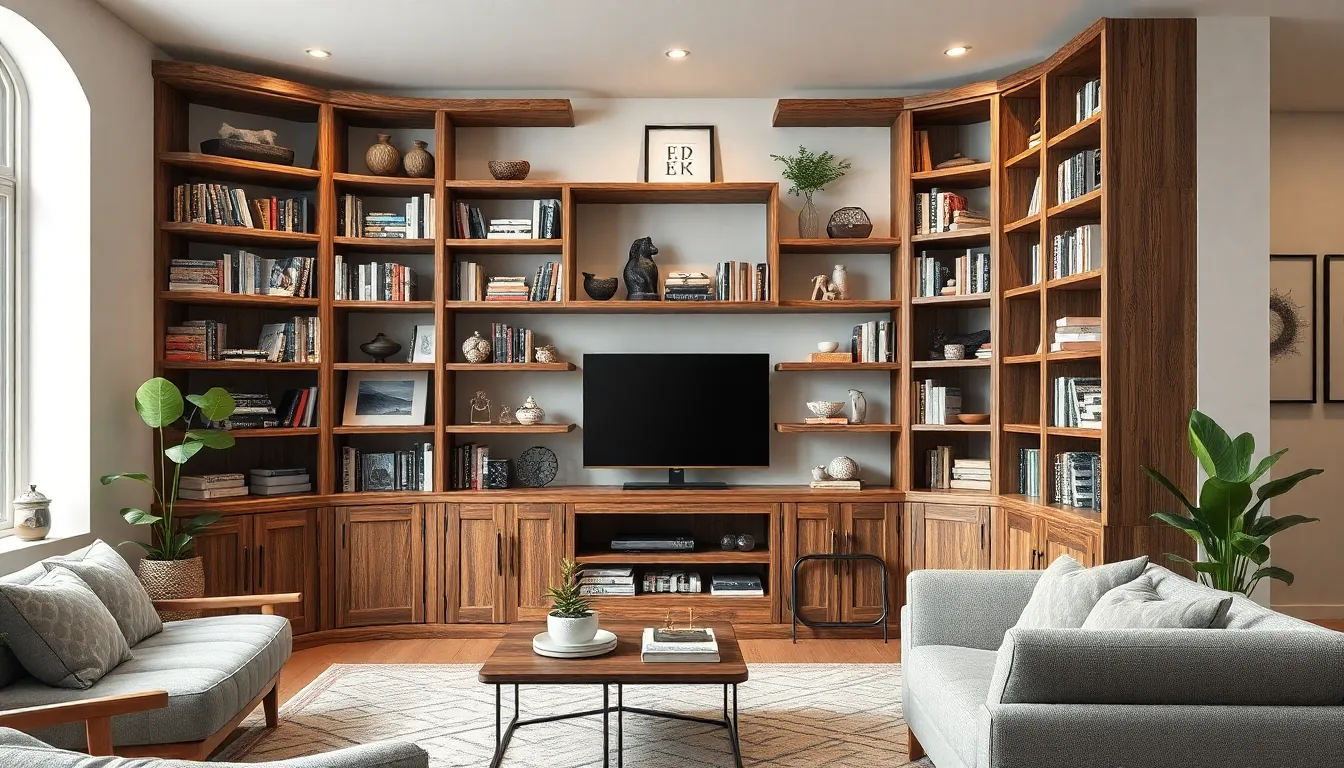
Corner bookshelves transform neglected triangular spaces into functional storage areas while adding visual interest to our rooms. We can maximize every inch of available space by choosing designs that fit snugly into corners and complement our existing decor.
Triangular Space Utilization
Triangular spaces become valuable storage areas when we install corner bookshelves designed specifically for these awkward angles. Measurement plays a crucial role in successful corner bookshelf installation since we must ensure the width, depth, and height accommodate both our room dimensions and the items we plan to display.
Scale matters significantly when arranging items on corner shelves because we need to balance large and small objects to maintain visual harmony throughout the space. Modern sleek designs work exceptionally well in attics or dining rooms where we want to enhance the aesthetic without overwhelming the area.
Rustic wooden setups offer timeless appeal when we combine natural wood with complementary materials, creating a mix of open shelves and closed storage options. DIY projects using reclaimed wood or repurposed materials allow us to create unique corner bookshelves that reflect our personal style while staying budget conscious.
Rotating Corner Units
Rotating corner units provide ever-changing functionality that allows easy access to our books and decorative items without creating obstructions in tight spaces. These units work especially well in small rooms where we have limited access to traditional shelving arrangements.
Less common than fixed corner shelves, rotating units offer innovative answers for rooms where we need maximum flexibility and convenience. We can easily browse our entire collection by simply spinning the unit rather than reaching around fixed corners or moving furniture.
Multi-Level Corner Displays
Multi-level corner displays offer ample storage capacity while creating compelling visual interest in our rooms through varied shelf heights and configurations. Asymmetrical shelving designs adapt perfectly to unique room shapes like slanted ceilings, where one side can be taller than the other to accommodate architectural constraints.
Open and closed storage combinations work beautifully in multi-level displays because we can showcase our favorite books and collectibles on open shelves while keeping less attractive items hidden behind closed doors. These versatile arrangements let us customize our storage answers based on both functional needs and aesthetic preferences.
Strategic placement of items across multiple levels creates depth and dimension that draws the eye upward, making our rooms appear larger and more sophisticated.
Creative Repurposed Bookshelf Ideas

We’ve discovered that some of the most stunning bookshelf designs come from transforming everyday items into functional storage answers. Repurposing materials not only saves money but also creates unique conversation pieces that add character to any room.
Vintage Ladder Transformations
Book ladders create rustic charm by transforming old wooden stepladders into eye-catching storage displays. We recommend leaning vintage ladders against walls and placing books directly on the rungs for an instant conversation-starting piece of furniture. This approach works particularly well in farmhouse or industrial-style interiors where the weathered wood adds authentic texture.
Stability becomes crucial when converting ladders into functional bookshelves, so we suggest securing them to wall studs for safety. The stepped design naturally creates varying shelf heights that accommodate different book sizes while maintaining visual interest. Libraries and reading nooks benefit greatly from this repurposing technique since it maximizes vertical space without requiring permanent installation.
Crate and Box Arrangements
Old milk crates stack beautifully to form modular bookshelf systems that adapt to changing storage needs. We’ve found that reinforcing these plastic crates with screws ensures they can safely hold heavier book collections while maintaining their cube-like structure. Wall-mounted crate arrangements create floating storage that opens up floor space in smaller rooms.
Wooden wine cases offer premium aesthetics when repurposed as book storage systems with their natural compartments perfect for organizing collections. These cases stack on floors or mount to walls for reusable storage answers that showcase both books and decorative items. The built-in dividers help separate different genres or create designated spaces for special editions.
Stacking configurations allow us to customize height and width based on available space and collection size. Multiple crates can form L-shaped corner units or straight wall displays that grow with expanding libraries. This flexibility makes crate arrangements ideal for renters who need temporary yet attractive storage answers.
Old Furniture Conversions
Ikea furniture upcycles transform basic bookcases like the Billy and Laiva models into sophisticated storage systems with simple modifications. We recommend adding Pole-Wrap wood veneer to create reeded textures that elevate these affordable pieces into luxury-looking furniture. The Laiva bookcase converts into sleek wall-mounted shelves by cutting sections to size and attaching them to ceiling mounts.
Existing bookcase makeovers breathe new life into tired furniture through strategic material additions and design updates. Contrasting veneer applied to shelf backs creates visual depth while maintaining the original structure’s integrity. These modifications cost significantly less than purchasing new furniture while achieving custom-designed results.
Hungarian shelf techniques offer minimalist approaches to furniture conversion that maximize storage capacity without overwhelming room aesthetics. These easy-to-make modifications work particularly well on standard bookcases where we need to increase functionality while maintaining clean lines. The resulting pieces hold substantial book collections while preserving the simplified design principles that make spaces feel organized and calm.
Room Divider Bookshelf Designs

Transforming your space becomes effortless with bookshelf room dividers that create distinct zones while maintaining visual flow. We’ll explore strategic designs that maximize both storage and spatial definition.
Open-Back Accessibility
Open back bookshelves revolutionize room division by allowing access from both sides without creating visual barriers. We can position these dual access units in the center of open floor plans to define separate living areas while preserving sightlines throughout the space. Unlike solid walls, these transparent dividers maintain the airy feel of open concept layouts while providing practical book storage and display opportunities.
Double sided accessibility means family members can retrieve items from either direction, making these shelving units perfect for shared spaces between kitchens and dining areas. We find that open back designs work exceptionally well in studio apartments where every square foot matters and complete room separation would make spaces feel cramped.
Double-Duty Functionality
Bookshelf room dividers deliver triple benefits by combining storage, privacy, and aesthetic enhancement in one strategic piece. We can maximize their storage potential by incorporating both open shelving for books and closed compartments with storage bins for household items. These versatile units become focal points that enhance room decor while organizing everything from literature collections to decorative objects.
Visual separation occurs naturally as these towering storage answers create defined zones without permanent construction. We often see homeowners use them to separate home offices from living areas or create reading nooks within larger rooms. Their functionality extends beyond books to include displaying artwork, plants, and personal collections that reflect individual style.
Privacy and Storage Balance
Achieving optimal privacy levels requires strategic height selection based on your exact room division needs. We recommend taller bookcases reaching 6 to 8 feet for maximum room definition and visual separation between distinct living areas. Lower units measuring 4 to 5 feet provide subtle space definition while preserving open sightlines across rooms.
Traffic flow considerations demand positioning these dividers to allow at least 3 feet of walking space around all sides to prevent crowding. We’ve found that placing units perpendicular to main walkways rather than parallel creates more natural movement patterns throughout divided spaces. Smart positioning also involves considering natural light sources to ensure both sides of the divided room receive adequate illumination throughout the day.
Under-Stair Bookshelf Installations
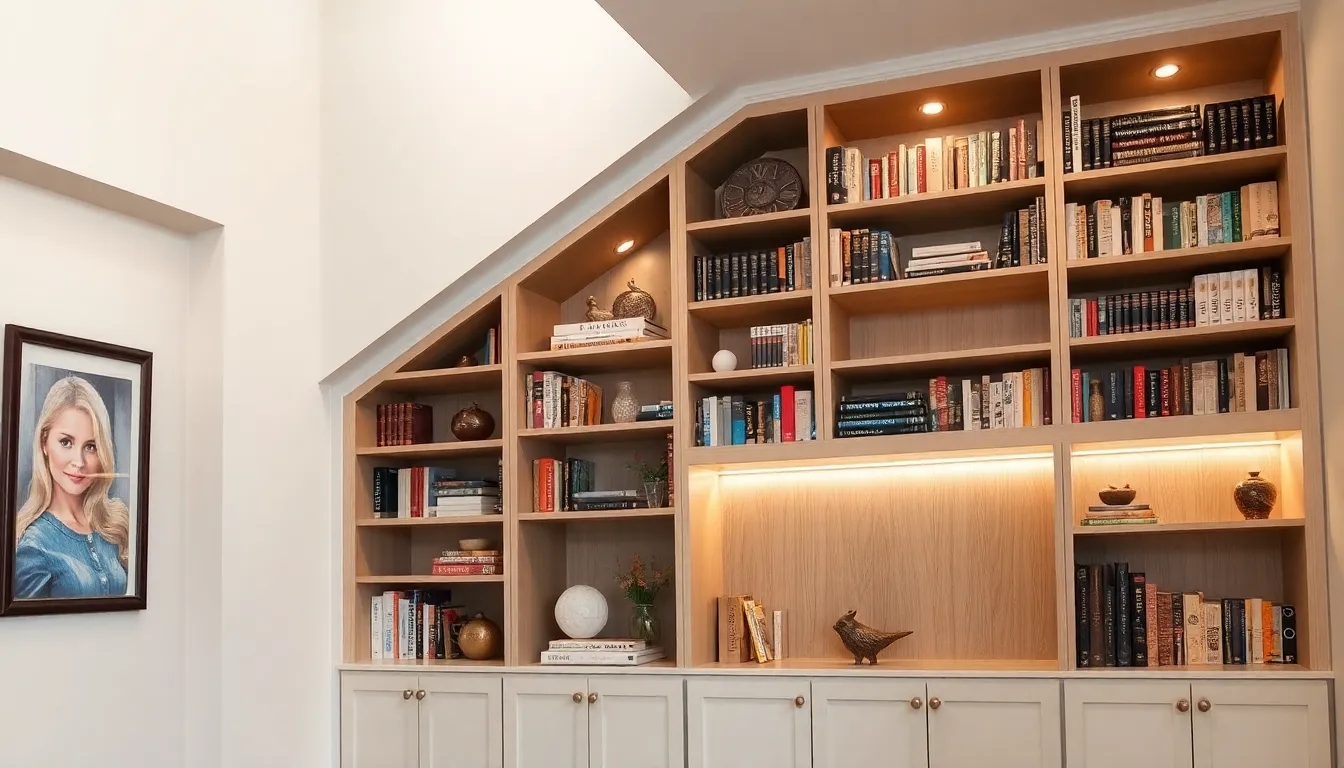
Transform that forgotten triangular space beneath your stairs into a stunning literary showcase that maximizes every square inch of your home. We’ll explore innovative approaches that seamlessly blend storage functionality with aesthetic appeal.
Custom-Fit Measurements
Custom measurements ensure your under stair bookshelf installation utilizes every available inch of that uniquely shaped space. We recommend measuring the height at multiple points along the staircase since the sloped ceiling creates varying dimensions throughout the area. Professional measurements account for structural elements like support beams, electrical outlets, and HVAC ducts that might affect your design.
Precise calculations allow us to create shelving that follows the natural angle of your staircase while maintaining proper proportions. Digital measuring tools and 3D modeling software help visualize how books and decorative items will fit within the triangular constraints. Successful installations require measurements that factor in door swing clearances and foot traffic patterns around the staircase area.
Pull-Out Drawer Systems
Pull out drawer systems maximize accessibility in deep under stair storage areas where reaching items becomes challenging. We install these sliding mechanisms on heavy duty tracks that support substantial weight loads while maintaining smooth operation over time. Full extension drawer slides ensure you can access items stored at the very back of each compartment.
These systems work particularly well for storing children’s books, magazines, and smaller decorative objects that might get lost in traditional shelving arrangements. Soft close mechanisms prevent slamming and protect both the drawer contents and surrounding structure. Multiple drawer heights accommodate everything from paperback novels to large format art books while keeping everything organized and easily retrievable.
Hidden Storage Compartments
Hidden compartments transform under stair areas into secret storage havens that maintain your home’s clean aesthetic lines. We incorporate sliding panels that blend seamlessly with surrounding trim work, creating invisible storage for valuable books or personal items. Touch latch mechanisms eliminate the need for visible hardware while providing secure closure.
These concealed sections work exceptionally well for storing seasonal decorations, important documents, or collectible books that require protection from dust and light exposure. Spring loaded hinges ensure doors remain properly aligned while magnetic catches provide silent operation. Integrated lighting systems illuminate hidden compartments when opened, making it easy to locate exact items without disturbing the room’s ambient lighting.
Themed Bookshelf Styling Ideas
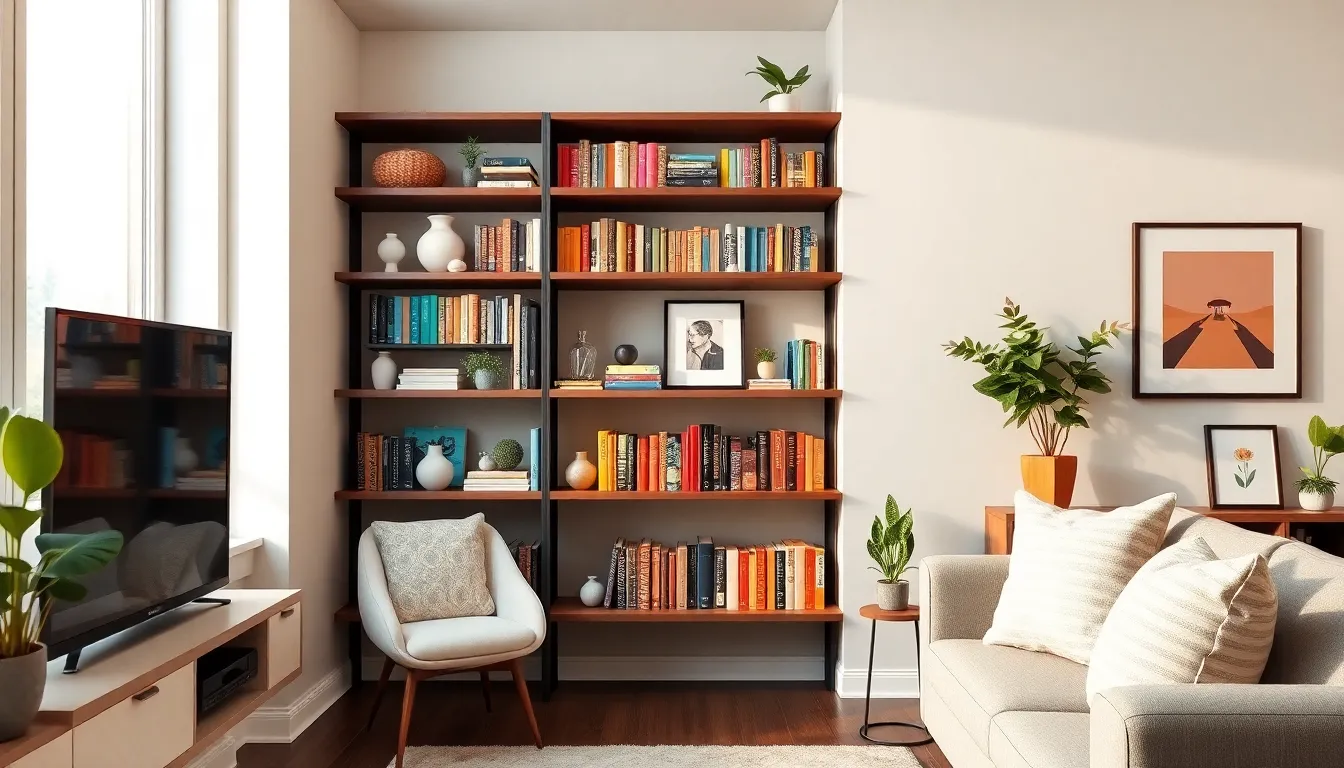
Creating cohesive themed displays elevates your bookshelf from simple storage to stunning focal points that reflect your personal style. We’ll explore strategic approaches that transform ordinary book collections into sophisticated design elements.
Color-Coordinated Book Arrangements
Arranging books by color creates visually striking displays that serve as living artwork for your walls. We recommend grouping similar hues together to establish bold color blocks that instantly catch the eye and create cohesive visual flow throughout your space.
Rainbow gradient arrangements offer the most dramatic impact, transitioning smoothly from deep purples through blues, greens, yellows, and warm reds. Start with your darkest tones at the bottom and gradually lighten as you move upward to create natural visual weight distribution.
Monochromatic groupings work exceptionally well in minimalist spaces, where books in similar tones like creams, whites, and soft grays blend seamlessly with neutral decor. This approach allows other decorative elements to take center stage while maintaining sophisticated visual harmony.
Accent color pops strategically placed throughout neutral book arrangements can tie together room color schemes. Place vibrant books like bright yellows or deep teals at eye level to create natural focal points that draw attention to your most treasured volumes.
Decorative Object Integration
Incorporating decorative objects transforms static book displays into ever-changing, personalized showcases that tell your unique story. We suggest mixing textures, heights, and materials to create visual depth that keeps viewers engaged and exploring your collection.
Artwork integration adds sophisticated gallery appeal when you lean framed pieces against the back wall of deeper shelves. This creates layered depth while showcasing both your literary collection and artistic taste in one cohesive display.
Sculptural elements like ceramic vases, metal figurines, or wooden bowls introduce organic shapes that break up rectangular book spines. Position these pieces at varying heights to create visual rhythm and prevent monotonous horizontal lines.
Functional bookends serve dual purposes when you choose pieces like vintage camera replicas, architectural models, or decorative globes. These items support your books while adding conversation starters that reflect your interests and hobbies.
Natural elements including small potted plants, interesting stones, or driftwood pieces bring organic texture that softens hard book edges. Succulents work particularly well as they require minimal maintenance while adding fresh green accents.
Seasonal Display Rotations
Rotating seasonal displays keeps your bookshelf arrangements fresh and captivating throughout the year while celebrating changing seasons. We rotate decorative elements quarterly to maintain visual interest and create anticipation for upcoming seasonal transitions.
Spring refreshes incorporate fresh greenery, pastel colored accessories, and lightweight fabrics that celebrate renewal and growth. Replace heavy winter items with delicate flowering branches, soft pink or yellow accents, and books with fresh, bright spine colors.
Summer transformations feature coastal elements like shells, coral pieces, and blue toned accessories that evoke vacation relaxation. Swap out darker books for lighter spines in whites, aquas, and sunny yellows that reflect summer’s bright energy.
Autumn updates embrace warm tones through copper vessels, dried leaves, and rich burgundy or orange accents that complement fall’s cozy atmosphere. Add books with earth tone spines and incorporate natural elements like pinecones or small pumpkins.
Winter styling introduces festive elements like metallic ornaments, evergreen sprigs, and rich jewel tones that create warm, inviting displays during colder months. Include books with deep red, forest green, or gold spines that echo traditional holiday colors.
Small Space Bookshelf Solutions
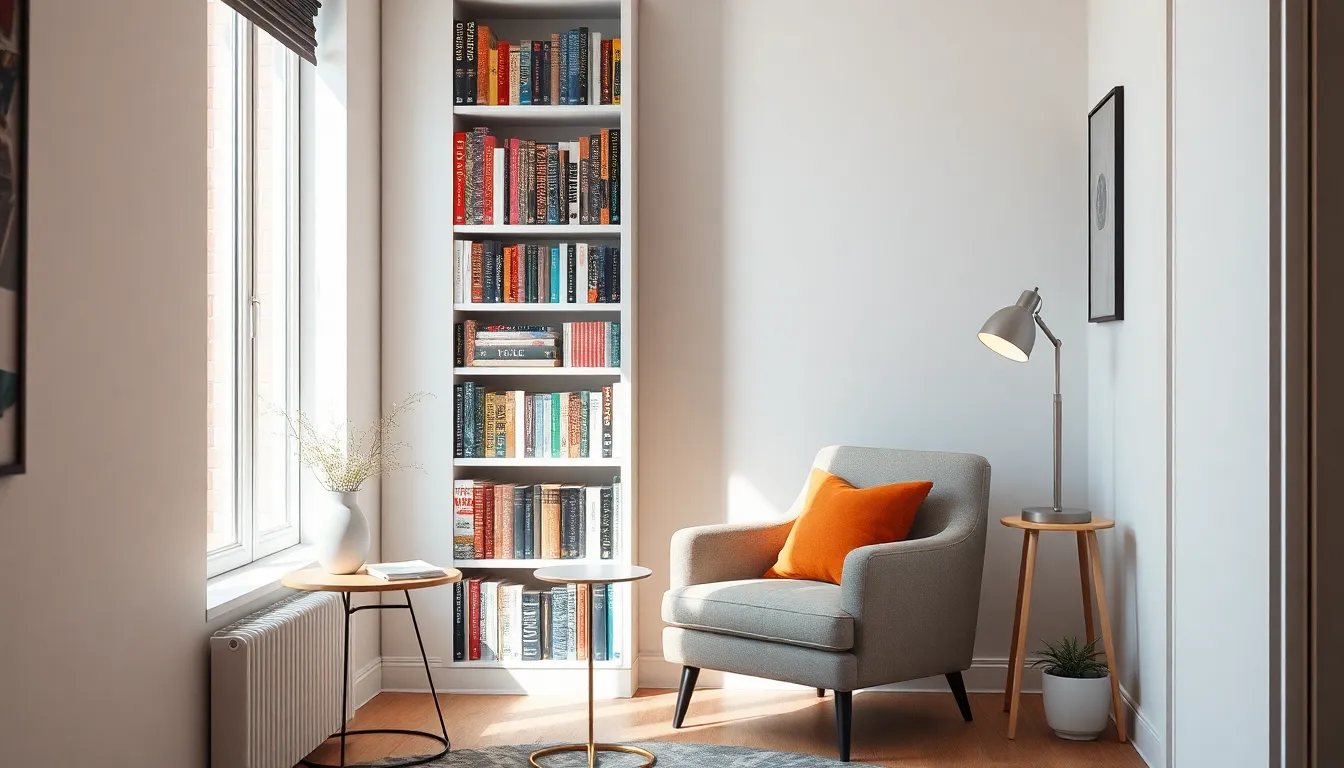
Maximizing storage in compact living spaces requires strategic thinking and creative design choices. We’ll explore space-saving bookshelf answers that transform even the smallest areas into organized literary havens.
Narrow Vertical Designs
Slim bookcases deliver maximum storage impact while consuming minimal floor space in apartments and cozy reading nooks. These cube-style vertical units fit perfectly in tight spaces between furniture pieces or alongside narrow hallways. We recommend measuring your available width carefully to ensure these streamlined designs complement rather than crowd your space.
High shelves capitalize on unused vertical wall space without sacrificing precious floor area. Installing these elevated storage answers draws the eye upward and creates the illusion of taller ceilings in small rooms. Consider mounting floating shelves in a vertical column arrangement to display your favorite titles while maintaining an open, airy feel below.
Over-Door Hanging Systems
Over-the-door bookshelves transform overlooked door spaces into valuable storage real estate without requiring permanent installation. These hanging systems use the area above bedroom, closet, or bathroom doors that typically remains empty and unproductive. We find these answers particularly effective in dorm rooms and rental properties where drilling holes isn’t permitted.
Adjustable door racks accommodate various book sizes while providing easy access to frequently used titles. Most over-door systems feature multiple shelves with protective rails to prevent books from sliding off when doors open and close. These installations work best on solid doors rather than hollow core options to ensure adequate weight support.
Multi-Purpose Furniture Options
Built-in bookshelves integrate seamlessly into awkward spaces like the area between radiators or under sloping ceilings where traditional furniture won’t fit. These custom installations add storage capacity without cluttering rooms or disrupting natural traffic flow. We’ve seen impressive results when these built-ins incorporate reading lights and charging stations for modern convenience.
Combination furniture pieces serve double duty by housing books while providing additional functionality like workspace or seating. Desks with integrated bookshelf towers create efficient home office setups that keep reference materials within arm’s reach. Ottoman storage benches with built-in book cubbies offer seating plus literary storage in living rooms and bedrooms.
DIY cottage-style projects using reclaimed wood and simple construction techniques can create charming custom answers at budget-friendly prices. Building your own shelving allows precise measurements for unusual spaces while adding personal character to small rooms. These handcrafted pieces often become conversation starters that showcase both your book collection and creative skills.
DIY Bookshelf Project Ideas

Building your own bookshelf transforms woodworking dreams into functional reality while creating customized storage that perfectly fits your space. We’ll guide you through essential plans, materials, and assembly techniques that make DIY bookshelf construction both achievable and rewarding.
Basic Woodworking Plans
AlmFab Bookcase Plan delivers impressive results with its 90″ x 70″ x 14″ design that’s built in 5 separate pieces for effortless movement and installation. This comprehensive plan requires plywood, hardwood, screws, shelf pins, and essential tools like a drill and table saw to create a substantial storage solution.
Kreg Tool Plans offers 15 free bookcase designs with detailed step-by-step guides and clear diagrams that help both beginners and experienced woodworkers tackle various bookshelf styles. These plans include material lists, cutting schedules, and assembly sequences that streamline the entire building process.
Cubby Bookshelf designs feature large modular construction with adjustable shelves that work perfectly in kids’ rooms or playful spaces. Video tutorials and finished project photos guide builders through each stage of construction while showcasing the versatile storage possibilities.
Limbert Bookcase plans showcase Arts & Crafts styling with elegant tapered legs and sophisticated glass door options. Easy joinery techniques make this historical woodworking style accessible to modern DIY enthusiasts who appreciate timeless design elements.
Modern Bookshelf variations from Ana White include industrial and farmhouse styles that complement different home decor themes. These contemporary designs adapt traditional bookshelf concepts to suit current interior design trends.
Budget-Friendly Materials
Plywood serves as the most economical and versatile foundation material, available in multiple thicknesses that accommodate various shelf spans and weight requirements. This engineered wood product works exceptionally well for bookshelf shelves and backing panels.
Hardwood provides structural integrity and aesthetic appeal for frames and decorative elements, though it costs more than plywood options. Oak, maple, and pine offer different grain patterns and durability levels that suit various project budgets.
Screws and shelf pins form the essential hardware backbone of any bookshelf project, securing assemblies and enabling adjustable shelf configurations. Quality fasteners ensure long-term stability while adjustable pins accommodate changing storage needs.
Basic woodworking tools like drills and table saws complete the material requirements without demanding expensive specialty equipment. Most DIY bookshelf projects succeed with standard home workshop tools that many builders already own.
Step-by-Step Assembly Guides
Photo documentation accompanies most DIY bookshelf plans, showing each assembly stage with clear visual references that eliminate guesswork during construction. These detailed images capture critical alignment points and proper technique demonstrations.
Diagram illustrations provide technical drawings that clarify measurements, joint locations, and hardware placement throughout the assembly process. Step-by-step visual guides help builders understand complex connections before making irreversible cuts or joins.
Video tutorials enhance written instructions by demonstrating proper tool techniques and assembly sequences in real-time. Moving images capture nuances that static photos can’t convey, especially for complex joinery operations.
Materials preparation guides outline cutting schedules, edge treatments, and pre-assembly steps that ensure smooth construction flow. Proper preparation prevents costly mistakes and reduces assembly time significantly.
Finishing instructions complete the assembly guides by covering sanding sequences, stain application, and protective coating techniques. These final steps transform raw wood assemblies into polished furniture pieces that enhance any room’s appearance.
Conclusion
We’ve explored countless ways to transform your space with thoughtful bookshelf design – from floating minimalist displays to grand floor-to-ceiling installations. Each solution we’ve covered offers unique benefits that can enhance both storage capacity and visual appeal in your home.
The beauty of these bookshelf ideas lies in their adaptability. Whether you’re working with a cozy apartment or spacious library your perfect storage solution exists among these options. From DIY projects that save money to custom built-ins that maximize every inch these approaches ensure your books become an integral part of your home’s design story.
Remember that the best bookshelf isn’t just about storage – it’s about creating spaces that inspire you to read explore and display the things you love most.
Frequently Asked Questions
What are the best bookshelf options for small spaces?
For small spaces, consider narrow vertical designs that maximize wall height, floating shelves with invisible brackets, and multi-purpose furniture like storage ottomans with built-in shelving. Over-door hanging systems and corner units also help utilize every inch efficiently without overwhelming compact rooms.
How do I install floating bookshelves securely?
Use invisible bracket systems like blind shelf supports or French cleat systems for a clean look. For drywall installations, toggle bolts provide essential stability. Always check weight limits and ensure brackets are properly anchored to wall studs for heavier book collections.
What’s the difference between built-in and freestanding bookshelves?
Built-in bookshelves are custom-designed to fit specific spaces, maximizing storage and creating seamless integration with room architecture. Freestanding options like ladder-style shelves offer flexibility and can be moved easily, making them ideal for renters or frequently changing layouts.
How can I style my bookshelves to look more decorative?
Create visual interest by arranging books by color, mixing in decorative objects like artwork and plants, and varying heights with bookends. Use the rule of thirds, incorporate negative space, and rotate seasonal displays to keep arrangements fresh and personalized.
What materials work best for DIY bookshelf projects?
Plywood offers affordability and versatility, while hardwood provides durability and premium appearance. Pine is budget-friendly for beginners, and reclaimed wood adds character. Choose materials based on your skill level, budget, and desired aesthetic outcome.
How do I measure for under-stair bookshelf installation?
Measure the triangular space carefully, accounting for structural elements like support beams. Consider the stair angle, available depth, and headroom clearance. Custom-fit measurements ensure maximum storage utilization while maintaining safe passage and proper proportions.
Can bookshelves work as room dividers?
Yes, open-back bookshelf designs create distinct zones while maintaining visual flow and allowing access from both sides. They’re perfect for studio apartments and shared spaces, providing storage, privacy, and aesthetic enhancement without completely blocking light or airflow.
What lighting options work best for bookshelf displays?
LED strip lights provide ambient illumination, while spotlights offer focused task lighting for reading areas. Battery-operated puck lights work well for floating shelves, and integrated lighting systems can transform bookshelves into curated gallery displays highlighting special collections.
How do I create geometric bookshelf arrangements?
Use asymmetrical patterns with clustered rectangular shelves for visual interest. Incorporate unique shapes like triangles and hexagons as accent pieces. Vary shelf heights and spacing to create dynamic compositions that break away from traditional linear arrangements.
What are the most budget-friendly bookshelf solutions?
Repurpose items like vintage ladders, milk crates, and wine cases for unique storage. DIY projects using reclaimed wood offer character at low cost. Upcycling existing furniture like IKEA pieces with simple modifications creates sophisticated storage without breaking the budget.

